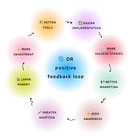📈 #92 Operations Research 2.0: an open letter
Why usability beats elegance, how DecisionOps closes the gap, and a pragmatic curriculum for Master’s programs.
Last year around these dates, I wrote a six-part series of articles.
I don’t know if it’s the time of the year, but I wanted to do an update to those articles.
I think most of the blame goes to having read a research paper from Laura Albert et al. where they explore the same topic.
You guessed it right: I’m talking about the systemic issues that keep OR from mainstream adoption and how to improve the situation for our field.
We reached to similar conclusions, and that’s a good sign but also a reminder that knowing what to change isn’t the same as changing it.
So today in Feasible we’ll cover:
🛣️ Alignment (and where to go further)
🪛 The tools to make it happen
📝 An open letter to Master’s programs: introducing the Product Track
Are you ready? Let’s dive in… 🪂
🛣️ Alignment (and where to go further)
If you didn’t read my OR Reimagined series of articles nor the research paper, I strongly suggest you do.
But if you don’t want to spend time now, there are some points covered in them, like:
🪟 The accessibility and transparency gaps.
OR tools require specialized knowledge and there’s a steep learning curve; you can see that issue reflected on the many PhDs or advanced Master’s programs needed for the jobs.
Compare it to Machine Learning where you just need to import a library and 10 lines of code after that you can classify cats and dogs.
On the transparency, it’s ironic because OR is mathematically transparent but practically opaque.
There are some efforts on explainable optimization (XOpt) like expopt or the way some solvers like Timefold can structure the output to explain it better.
📜 The lack of marketing/storytelling. Most of the OR successes are invisible either because of confidential reasons (saving millions with route optimization is usually proprietary), or because the field itself is not widely known.
And in this latter part, the name may play a crucial role.
One year ago I argued we didn’t need a change on that part. Now I think we don’t need that urgently, as I don’t think it’s the primary reason for the lack of knowledge around OR, but it could benefit the field.
Anyway, it seems that OR’s wins are infrastructure: invisible when working, catastrophic when failing. It’s like plumbing: nobody celebrates good plumbing, but everyone complains when it breaks.
↔️ The theory-practice divide. This is also a crucial point: what academia studies is usually irrelevant for the industry.
So there’s a big gap between the two. I see four parts where it shows up:
Problem selection. Academia usually studies problems because they’re theoretically sound, but the industry asks for things like optimizing routes for 50 trucks with messy data, while drivers aren’t following the routes and customers are constantly changing their minds.
Solution approach. While there might be value in achieving optimality for some problems, if it takes 4 hours then it’s -most probably- less useful than getting suboptimal solutions in 5 minutes.
Model complexity. In academic settings, you’re responsible for your code, but in industry settings you’ll work within a team that need to understand your code, or even worse, you’ll leave the company some day and someone else need to take care of it. So usually, the simpler, the better.
Code quality. The industry needs to run those beautiful algorithms and models in production environments, not in a lab. So they need things like automated tests, data preparation, error handling, logging and monitoring, documentation…
There’s one point in the paper that, at least to me, needs a bit more clarification.
As I was reading it, it seemed that open-source ecosystems are the main reason ML succeeded and the main bottleneck in OR. And that we don’t have open datasets.
On the contrary, the field is full of really good open-source solvers like HiGHS, Timefold, or CP-SAT (from Google OR-Tools), and there exist open datasets for the most common problems like the VRP, QAP, or CSPs. You can see a list of 40 solvers and 9 datasets (or pages with datasets of all kind) in my Notion database with OR resources.
The bottleneck isn’t code availability anymore; it’s usable pipelines and shared, decision-centric benchmarks. We need something like the Kaggle for OR.
And all of those points are a diagnosis, but they’re not a cure.
As a summary, what I think now is that academia doesn’t prepare engineers enough to i) build models easily (and easy models neither) nor ii) productize those models for others (backend and/or frontend systems) to consume it.
So if we agree on why, the next step is how: what tools make this change possible?
🪛 The tools to make it happen
If you remember the Part II of OR Reimagined, I showed what are the missing layers when solving optimization problems, and I identified two specific layers.
🗣️ Problem definition.
There’s this usability layer where math-heavy frameworks dominate the OR world.
One of the main issues I saw when I started solving optimization problems is that you either needed big math foundations or big algorithm foundations. If we want to appeal to those outside our field as ML does, we need the “import a library and 10 lines of code after that you can classify cats and dogs” kind of thing.
But we don’t have that.
The most engineering-friendly modeling approach I’ve used so far is Timefold, and I’d be very happy to see more solvers like that one. Why? Because it lets every software engineer model optimization problems without being mathematicians or algorithms experts.
Instead of writing…
minimize ∑ c_ij * x_ij
subject to ∑ x_ij = 1
You can simply write…
(...)
private Constraint assignEachTask(ConstraintFactory factory) {
return factory.forEach(Assignment.class)
.join(Task.class, Joiners.equal(Assignment::getTask, Task::getId))
.penalize(HardSoftScore.ONE_HARD)
.as_constraint(”Assign each task once”);
}
(...)
The constraint is -more- readable.
The model itself is -more- testable.
And the developer doesn’t need a PhD.
♻️ Deployment: from prototype to DecisionOps.
DecisionOps is to OR what MLOps is to ML.
But we need similar things in this regard:
🔢 Versioning and experimentation. Each model run tracked so we can compare solutions through different parameterizations.
🧪 Testing. So that we can confidently develop new constraints or change them without fear of breaking everything.
🔍 Monitoring. The thing needed to watch KPIs over time or performance degradation.
If you don’t want to write an entire DecisionOps pipeline yourself, you have proprietary tools like Nextmv and also open-source ones like Cornflow.
For both -problem definition and deployment- the tools exist today. What’s missing is connecting them into a reusable pipeline. The technology is ready; the mindset isn’t.
How can we change that?
📝 An open letter to Master’s programs: introducing the Product Track
The other day I let ChatGPT to do some research about Master’s programs worldwide. The output was pretty long, but it can be summarized as:
Graduates are highly employable for modeling and analytics, but a truly product-aware OR engineer usually layers on extra training in software engineering and business communication & product sense.
To be fair, that was my main hypothesis. In fact, you can see that reflected on this very same newsletter as I’m usually linking my posts to those topics. So…
If I could write one letter to any OR department in the world, it would say something like the following.
“Mathematical rigor and algorithmic excellence are our identities, our assets.
Those are the things for which companies pay a lot of money in every industry.
Cost savings, margins improvement, or reducing the carbon footprint can be achieved thanks to our specific knowledge.
We just need one more step towards offering the industry what it deserves: engineers able to build, ship, and adopt that knowledge in any organization:
🏗️ Build
The goal at this phase should be to translate optimization models into usable software. A mathematical model or an algorithm is not the same thing as having an optimization engine that can be connected to other parts of the software.
We can leverage tools like FastAPI or Flask to develop APIs so the models become callable, and if we stand to reproducibility as we do with algorithms, we should teach containerizing tools like Docker.
This is what moves algorithms from “it works on my machine” to “it works everywhere”.
🚢 Ship
The goal here should be to integrate the best practices from software engineering so that we can safely move the optimization engine to production environments.
We can include here things like automated testing with tools like pytest or Junit, and some CI/CD ideas to productize engines more easily with GitHub Actions and the like.
This will create a working pipeline that runs tests automatically before moving trustable code to production.
🪡 Adopt
The goal here should be to connect optimization outcomes to business language, including all the stakeholders in the conversation.
Clear communication through business KPIs and simple dashboards is key to explaining results to non-technical users.
Tools like Streamlit or Plotly Dash may help here.
In this Master’s program, the math and algorithms remain. The difference is that students graduate knowing how to put their models into motion.”
→ If you can’t wait for your university to build this track, build it yourself:
Take a FastAPI course.
Containerize one of your models with Docker.
Develop tests with pytest.
Setup CI/CD for automated testing with GitHub Actions.
Build a simple UI that connects to the optimization engine and show results in Streamlit.
That way, you’ll get all the tools in your arsenal to be the OR Engineer that the industry is looking for.
🏁 Conclusions
One year ago, I described some of the most pressing issues in our field: commoditization, mindset, marketing, and practicality.
A couple months ago, Laura Albert et al. somehow validated it academically by identifying those issues and comparing Operations Research to Machine Learning. It can be incredibly useful, as long as we approach it with intention. They also suggested 10 actions to take to improve the situation.
Now I’m updating my thoughts and providing a path forward built on usability and education reform.
The tools exist. The education path is clear. Let’s hope everything aligns in the next few years.
But one of the tools we’ve seen today, DecisionOps -treating OR like software, with versioning, testing, and monitoring- deserves its own deep dive. I’ll explore that soon.
And then there’s Agentic AI. I’ve recently read about a job posting from one of the biggest retailers worldwide where they want expertise in OR and Agentic AI. Think it carefully: it’s a signal of what’s going to come. Agents are here to make automated decisions and assist users in a new fashion way. And those decisions will need OR at their core.
If we succeed, OR will become invisible for the right reason: not because it’s forgotten, but because it’s everywhere, powering the agents that reason, plan, and decide.
Let’s keep optimizing,
Borja.








